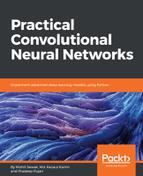In 2001, Paul Viola and Michael Jones proposed a solution that could work well to answer some of the preceding challenges, but with some constraints. Though it is an almost two decades old algorithm, some of the most popular computer vision software to date, or at least till recently, used to embed it in some form or another. This fact makes it very important to understand this very simple, yet powerful, algorithm before we move on to CNN-based approaches for Region Proposal.
This algorithm is not only capable of delivering detections with high TPRs (True Positive Rates) and low FPRs (False Positive Rates), it can also work in real time (process at least two frames per second).
The constraints of their proposed algorithm were the following:
- It could work only for detecting, not recognizing faces (they proposed the algorithm for faces, though the same could be used for many other objects).
- The faces had to be present in the image as a frontal view. No other view could be detected.
At the heart of this algorithm are the Haar (like) Features and Cascading Classifiers. Haar Features are described later in a subsection. The Viola-Jones algorithm uses a subset of Haar features to determine general features on a face such as:
- Eyes (determined by a two-rectangle feature (horizontal), with a dark horizontal rectangle above the eye forming the brow, followed by a lighter rectangle below)
- Nose (three-rectangle feature (vertical), with the nose as the center light rectangle and one darker rectangle on either side on the nose, forming the temple), and so on
These fast-to-extract features can then be used to make a classifier to detect (distinguish) faces (from non-faces).

These Haar-like features are then used in the cascading classifiers to expedite the detection problem without losing the robustness of detection.
The Haar Features and cascading classifiers thus led to some of the very robust, effective, and fast individual object detectors of the previous generation. But still, the training of these cascades for a new object was very time consuming, and they had a lot of constraints, as mentioned before. That is where the new generation CNN-based object detectors come to the rescue.
